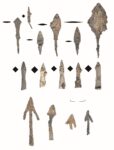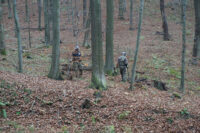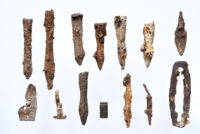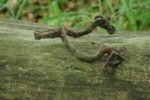 Archaeologists have discovered a previously unknown medieval battlefield on a forested mountain near Sanok, southeastern Poland. The team unearthed more than 200 arrowheads and crossbow bolts from the mid-1300s, the reign of Casimir the Great of Poland.
Archaeologists have discovered a previously unknown medieval battlefield on a forested mountain near Sanok, southeastern Poland. The team unearthed more than 200 arrowheads and crossbow bolts from the mid-1300s, the reign of Casimir the Great of Poland.
The site is on Biała Góra, a peak of the Słonne Mountains. It came to archaeologists’ attention from reports of widespread looting taking place there. It was known to have had a fortified settlement in the late Middle Ages, but it was believed to have been built by the redoubtable Bona Sforza,  Queen of Poland and wife of Sigismund I the Old, in the 16th century. The last time the site was archaeologically investigated was 50 years ago and none of the documentation from that survey is extant today. Treasure hunters flocking to the site with metal detectors suggested there was something to be found there and spurred new archaeological fieldwork.
Queen of Poland and wife of Sigismund I the Old, in the 16th century. The last time the site was archaeologically investigated was 50 years ago and none of the documentation from that survey is extant today. Treasure hunters flocking to the site with metal detectors suggested there was something to be found there and spurred new archaeological fieldwork.
The evidence of extensive looting dotted the hillside — numerous pits on the surface and iron objects of little interest to treasure hunters left behind. The great quantity of arrowheads and bolts were an unexpected discovery because they date to the mid-14th century and there is no specific record of a battle taking place there at that time. There sure was a lot of fighting going on in the area, however.
 After Bolesław-Jerzy II, Piast dynasty ruler of the Ruthenian principality of Galicia, was poisoned to death by local nobles in 1340, Casimir III the Great of Poland inherited the kingdom. This was not an undisputed succession, to put it mildly, and Ruthenian noblemen, the Grand Duchy of Lithuania and the Kingdom of Poland went to war to pursue their claims to the principality. Ultimately Casimir came out on top, and in 1344 he annexed Galicia, adding 20,000 square miles and 200,000 people to the Kingdom of Poland.
After Bolesław-Jerzy II, Piast dynasty ruler of the Ruthenian principality of Galicia, was poisoned to death by local nobles in 1340, Casimir III the Great of Poland inherited the kingdom. This was not an undisputed succession, to put it mildly, and Ruthenian noblemen, the Grand Duchy of Lithuania and the Kingdom of Poland went to war to pursue their claims to the principality. Ultimately Casimir came out on top, and in 1344 he annexed Galicia, adding 20,000 square miles and 200,000 people to the Kingdom of Poland.
Chroniclers record that Casimir’s army took a number of castles when they invaded in 1340. The hillfort on Biała Góra may have been one of them. If so, its defensive response was weak as very few artillery projectiles were  found with the arrowheads and bolts. The fortress was small, encircled by a single earthenware embankment and a dry moat. The highest concentration of bolts and arrows were found within the stronghold and right next to it. The attack came from the south and the remains of the embankment bear evidence of having been burned, so it seems the fort took heavy fire and was unable to dish any out.
found with the arrowheads and bolts. The fortress was small, encircled by a single earthenware embankment and a dry moat. The highest concentration of bolts and arrows were found within the stronghold and right next to it. The attack came from the south and the remains of the embankment bear evidence of having been burned, so it seems the fort took heavy fire and was unable to dish any out.
Good friends,
As an medieval archery geek, I was really delighted to see this selection of points, and can offer you a few comments.
In the first illustration, most of the points are probably from arrows, based on their size, There familiar socketed points, and also tanged points (with an extension like the end of a file, to go into a hole drilled into the arrow shaft’s end). I suggest the larger “leaf-shaped” points are actually hunting points, based on similar western European examples, but I’m not really up on east European archery, so all bets are off. A peasant archer pressed into military service would have brought what ammunition he had, and a hunting point can kill a lightly-armored enemy soldier as surely as a military point.
In the second group, we see mostly larger points, which are likely from crossbow bolts. The photo includes a modern shell casing for comparison. I suspect this is an 8-10 mm bullet, which is comparable in size to an American .45 calibre round.
The second group includes a metal plate with two holes punched/drilled through. This is possibly a “lame” or plate from lamellar armor, a type known to have been used in eastern Europe: https://en.wikipedia.org/wiki/Lamellar_armour . Alternatively, it could be from a “jack of plates”, a leather coat with iron “scales” sewn on.
Finally, the object in the last illustration is a cavalryman’s spur.
Yours Aye,
Mungo Napier, Laird of Mallard Lodge 🦆 (SCA)
(aka Garth Groff)
The “battlefield artifact” in the last photo is a spur.
Also, I doubt the 20th century pistol cartridge case in the bottom row of the next to last photo dates to the 14th century unless a time traveler got caught up in the fracas.
So we have an unknown 14th century battle that took place at a fortified settlement built in the 16th century, where someone dropped a 20th century cartridge case. It all makes complete sense. 😆
I love our astute readers. I would have never noticed the 20th century parts.
You indeed noticed that the sizes are not given inches or centimeters but in 20th century cartridges :yes: …Also, Biała Góra in the nearby ‘Salt Mountains’ is not to be confused with the Biała Góra housing estate in Sanok itself.
The term Zamczysko (from ‘zamek’) was referred to me as ‘ugly keep’, but in fact its meaning is most likely that of a ‘Burgstall’, i.e. a minor (and often almost vanished) “castle site”. Apparently the one in question here was much less important than the nearby stronghold of Sanok. If the attack came indeed from the south, it happened presumably after Sanok castle had already been taken.
—————–
Freshly machined from Polish:
“On one of the side branches, the main hill, on a clear climax of about 470 m above sea level there is a well-preserved fortified settlement. It is an oval-shaped mound with a trench and a rampart, where traces of settlements from the 12th-13th century were also discovered. The mound bears traces of destruction in battle (traces of burning, numerous caves made of propelling weapons) dating back to the beginning of the 14th century and associated with border fights from the times of Casimir the Great immediately before the Polish Kingdoms took over the area (1340). It was probably an auxiliary stronghold, protecting the San crossing. Below at the foot of the mountain, on the vast terrace of the San River and on the slopes of the White Mountain, traces of settlements from the Celtic culture circle with a large early-medieval subgroup were discovered. The place is now an ethnographic park. In May 2019, Mieczysław Skowroński, cooperating with the London British Museum, discovered a deposit of bronze products, tiles, beads and pendants that could be part of women’s clothing. The monuments dug out by the Sanok archaeologists are dated approximately 1000 B.C.”
Awesome blog. You are a great writer. I have benefited a lot from reading your blog. I was looking for a full guideline on air rifles and here I got. I feel glad that I read this article. I hope that the article on the best crossbow bolt makes a great addition to my knowledge. I confidently go into the market and purchase the best crossbow bolts that belong to my taste.